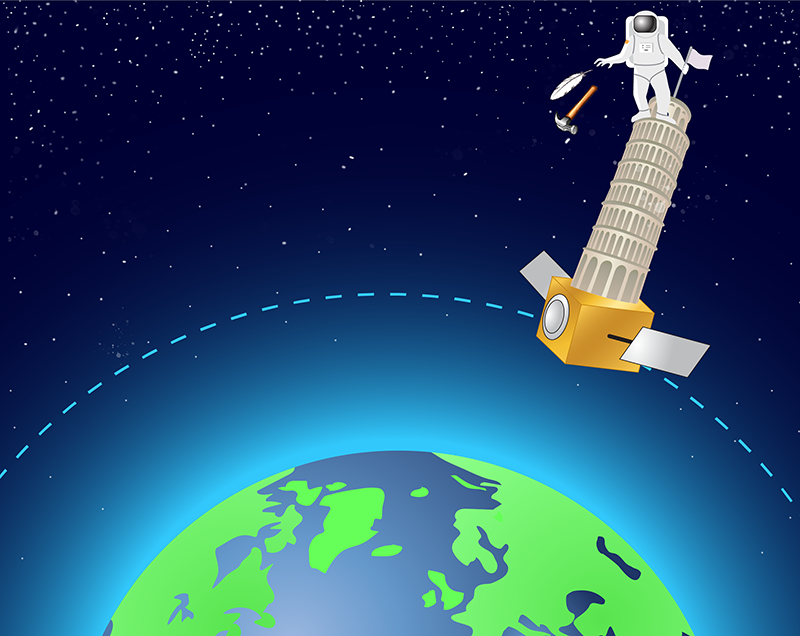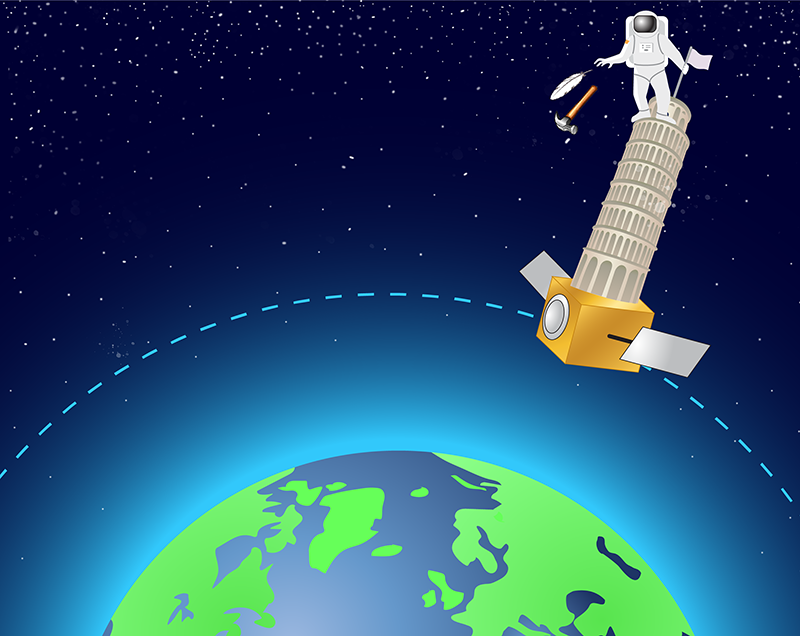Satellite Confirms the Principle of Falling
At an early age, we have all been taught one of the most counterintuitive facts about the physical world: two objects of unequal mass dropped in a vacuum will reach the ground simultaneously. Galileo allegedly tested this equivalence principle from the top of the Leaning Tower of Pisa in Italy, and so did the astronaut David Scott by dropping a hammer and a falcon feather at the surface of the Moon in 1971. And yet, we may find these observations disconcerting, as common sense would tell us that a heavier object should fall faster than a lighter one. But gravity is a peculiar interaction. To understand this force—and what it might tell us about other mysteries, such as dark matter and dark energy—we need to test it with ever-increasing precision. The new results by the space-borne MICROSCOPE mission have done just this. The experiment verified that two masses of titanium and platinum aboard a satellite orbiting Earth fall exactly in the same way to a precision of 1 part per 1015 [1]. This confirmation places the strictest bounds yet on alternatives to general relativity, which is currently our best model of gravity.
The equivalence principle was first discussed in the early 17th century by Kepler and Galileo, before reappearing later in Newton’s theory of gravity. That theory states that the gravitational force between two massive bodies is proportional to the product of their gravitational masses. The gravitational mass is a feature of massive bodies, playing the same role for gravitation as the electric charge for charged objects. But this is not the only mass in Newton’s theories: the second law of motion states that the inertial mass relates a body’s acceleration to the force acting on that body. Hence, massive bodies have two masses potentially—the gravitational and the inertial—but Newton assumed that they are the same. As a consequence, the motion of a massive body in the gravitational field of Earth (or of other large objects) should be independent of its mass.
This extraordinary prediction was first tested by Newton at the 1-part-per-1000 level using pendulums and employing their period of oscillation. Balls of different masses attached to a pendulum should oscillate with the same frequency, a property commonly used in standing clocks. The first improvement on this measurement was obtained in the 19th century by Friedrich Bessel who confirmed the equivalence with an accuracy of 1 part per 100,000. More accurate measurements appeared at the end of the 19th century with the work of physicist Loránd Eötvös, who used a torsion pendulum to confirm the equivalence principle to an accuracy of 1 part per 109. In honor of this groundbreaking experiment, the ratio between the acceleration difference of two massive bodies and their averaged acceleration is called the Eötvös parameter, 𝜂. The equivalence principle posits that 𝜂 is zero.
The Eötvös experiment helped usher in the next revolution in our understanding of gravitation: Einstein’s theory of general relativity, published in 1915. Einstein used the experimentally verified equivalence principle as the basis of his theory. In a famous thought experiment, he imagined placing a person holding an apple in an elevator just as the cables are accidentally cut. During the free fall, the person lets go of the apple, which hovers in place rather than falling to the floor. Gravity appears to be turned off owing to the equivalence principle. Einstein went even further and postulated that gravitation is an illusion; that moving bodies are simply free falling in spacetime. Einstein’s whole construction of general relativity relies on the validity of the equivalence principle.
One of the ways, then, to verify general relativity is by testing the equivalence principle. Progress on the measurement of the Eötvös parameter was steady in the 20th century; reaching levels of 𝜂≤10−13 with the Eöt-Wash experiment (an updated version of the Eötvös torsion balance at the University of Washington) [2] and with the lunar laser ranging (LLR) experiment [3]. Like Scott’s feather and hammer drop, LLR is an astronaut-assisted test of the equivalence principle, using mirrors installed on the Moon during the Apollo mission to reflect powerful laser beams sent from Earth. The reflected light helps in detecting tiny deviations in the Moon’s trajectory, which would then be interpreted as a violation of the equivalence principle by the Earth-Moon system falling in the gravitational field of the Sun.
The MICROSCOPE experiment—built by the French National Center for Space Studies (CNES)—is the next step in the quest for the perfect confirmation of the equivalence principle [4]. Launched in 2016, the satellite orbited Earth for two years at an altitude of 710 km. Being in space, the experiment freed itself from many of the systematic uncertainties inherent to Earth-bound measurements, such as the noise from seismic vibrations or the gravitational-field variations caused by nearby mountains. In the experiment, two coaxial cylinders of titanium and platinum were placed in free fall in Earth’s gravitational field. The cylinders were held in place by electrostatic forces that corrected for tiny perturbations on the satellite. The researchers looked for deviations in those correction forces, which would have signaled that the two cylinders were falling at slightly different rates and that the equivalence was violated. In 2017, MICROSCOPE published their first results, showing no sign of a violation at the level of 𝜂≤10−14. The new publication by the MICROSCOPE team confirms the earlier result, reaching the mission’s projected sensitivity of 𝜂≤10−15.
This important result is the first controlled experimental constraint on the equivalence principle obtained in space. Many theories of cosmology predict the existence of new interactions, which could affect the equivalence principle on different scales in the Universe and in particular in the Solar System. Some theories built to explain dark energy, for example, envisage that the equivalence principle could be violated in orbit around Earth [5]—claims that were recently revised [6]. The next generation of proposed experiments such as MICROSCOPE 2 should reach a level of precision of 𝜂≤10−17 and once more push theories to their limits.
Physicists hope that eventually these precision experiments will uncover violations that can lead to new physical theories to explain dark matter or dark energy. Evidence for dark matter and dark energy comes from large-scale observations, such as those of the cosmic microwave background and distant supernovae. Future galaxy surveys will test different cosmological models by probing the way that galaxies “fall” toward each other as they cluster. We can seriously envisage that dark matter and dark energy could be explained in the future by a modification of general relativity at cosmic scales. And thanks to the unity of physics on all scales, we expect that such a modification should eventually be detectable at smaller scales in the form of a violation of the equivalence principle in laboratory and satellite experiments. Will the next generation of experiments, such as MICROSCOPE 2, be able to find such a violation?
References
- P. Touboul et al. (MICROSCOPE Collaboration), “MICROSCOPE mission: Final results of the test of the equivalence principle,” Phys. Rev. Lett. 129, 121102 (2022).
- T. A. Wagner et al., “Torsion-balance tests of the weak equivalence principle,” Class. Quantum Grav. 29, 184002 (2012).
- J. G Williams et al., “Lunar laser ranging tests of the equivalence principle,” Class. Quantum Grav. 29, 184004 (2012).
- P. Touboul et al., “MICROSCOPE Mission: First results of a space test of the equivalence principle,” Phys. Rev. Lett. 119, 231101 (2017).
- J. Khoury and A. Weltman, “Chameleon fields: Awaiting surprises for tests of gravity in space,” Phys. Rev. Lett. 93, 171104 (2004).
- M. Pernot-Borràs et al., “Fifth force induced by a chameleon field on nested cylinders,” Phys. Rev. D 101, 124056 (2020).





